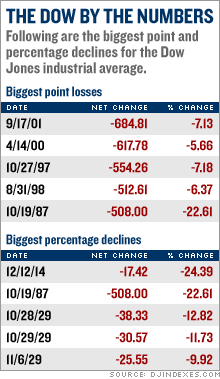Wall Street: Down but not outMajor gauges post small decline after big early drop; strong manufacturing report helps.NEW YORK (CNNMoney.com) -- Stocks ended lower Thursday, but the declines were minimal as investors showed their mettle after the market took another battering in the morning. The Dow Jones industrial average (Charts) ended down about 0.5 percent. The blue-chip barometer fell about 200 points near the open, clawed back into positive territory in the afternoon and then sputtered out near the close. The broader S&P 500 (Charts) index and the Nasdaq (Charts) composite both lost about 0.3 percent. Both major gauges had slumped more at the opening, turning positive in the afternoon before ending lower. Although stocks finished lower Thursday, the declines were modest, considering the more bearish outlook in the early going. Helping to temper stock losses: a strong read on manufacturing and the willingness of select buyers to step back in after Tuesday's sell-off and some heavy selling Thursday morning. Stocks managed modest gains Wednesday. After the close, Dell (Charts) reported lower quarterly earnings that topped estimates on lower quarterly revenue that missed estimates. Shares declined in extended-hours trading. No market-moving earnings reports are due Friday. The day's lone economic report is the revised reading on February consumer sentiment from the University of Michigan. Also on Friday, Federal Reserve Chairman Ben Bernanke speaks at Stanford, while St. Louis Federal Reserve Bank President William Poole speaks on the economy. Thursday's market All three major gauges slumped in the morning, trimmed losses at midday and then made an attempt to rise in the afternoon. But the advance proved short-lived, with stocks turning negative again near the close. "Today can kind of be looked at as an aftershock from the earthquake that hit Tuesday," said Steven Goldman, market strategist at Weeden & Co. This is typical of bull markets, he noted, where a big crack appears quickly, then there are aftershocks for a few days. This process helps the market edge out a bottom, he said, and appears to be what stocks are trying to do now. "Historically, if you look at the largest rallies, the first big declines clean out the excesses and then after that the market retests the previous high," Goldman said. Stocks scored modest gains Wednesday, helped by calming comments from Fed Chairman Ben Bernanke, as Wall Street tried to stabilize after Tuesday's sell-off that drove the Dow down 416 points, its biggest point loss since the day the market reopened after the Sept. 11 attacks. An almost 9 percent decline for the Shanghai market Tuesday is what got the ball rolling, creating a bit of a domino effect as markets in a variety of countries slumped in response to China and other developments. On Thursday, the pummeling resumed in the first half hour of trading, with the Dow down more than 200 points as investors eyed another sell-off in Chinese markets and a drop in European markets. Trying to limit declines, the New York Stock Exchange imposed downside trading curbs in the morning. As the morning wore on, the selling let up as a "cushion of cash" flowed into the market, said Fred Dickson, chief market strategist at D.A. Davidson & Co. "We have some investors who have been waiting for the kind of dip we've seen over the last few days and are using this as an opportunity to come back in," he said. Despite this, "the nervousness and change of sentiment that we've seen over the last few days is going to be with us for a while, at least until we see a turnaround in the global markets," Dickson said. Adding to worries for investors Thursday: a report showing that personal income and spending, as well as the report's closely watched inflation measure, all rose more than expected in January. That was countered by a report released after the start of trading showing a bigger than expected jump in the February ISM manufacturing index to a level that signals expansion in the sector. Another report showed a surprise hike in weekly jobless claims. In corporate news, software maker Oracle (Charts) said it will buy rival Hyperion (Charts) for $3.3 billion in cash. Motorola (Charts) inched higher on news that billionaire Carl Icahn and his group have filed to increase their stake in the company. (Full story). In addition, automakers were reporting February results during the day. General Motors (Charts) posted a surprise rise in February sales after the company said earlier this week that it would see a drop. Separately, the company said that it would miss a deadline to report quarterly results. Shares ended lower. Ford Motor (Charts) said sales slumped 13 percent in February, while DaimlerChrysler (Charts) said sales sank 8 percent. Market breadth was negative but improved from the morning. On the New York Stock Exchange, losers beat winners 5 to 3 on volume of 2.22 billion shares. On the Nasdaq, decliners topped advancers by almost 2 to 1 on volume of 2.70 billion shares. U.S. light crude oil for April delivery rose 21 cents to settle at $62 a barrel on the New York Mercantile Exchange. Treasury prices edged higher, lowering the yield on the benchmark 10-year note to 4.55 percent from 4.56 percent late Wednesday. Bond prices and yields move in opposite directions. In currency trading, the dollar gained against the euro and slumped versus the yen, with the Japanese currency surging as traders rushed to pay back yen loans following comments from Japan's finance official. COMEX gold for April delivery fell $7.40 to settle at $665.10 an ounce. |
|



